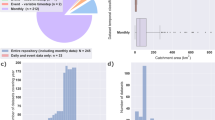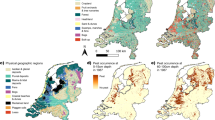Abstract
It is crucial for environmental monitoring to fully control temporal bias, which is the distortion of real data evolution by varying bias through time. Temporal bias cannot be fully controlled by statistics alone but requires appropriate and sufficient metadata, which should be under rigorous and continuous quality assurance and control (QA/QC) to reliably document the degree of consistency of the monitoring system. All presented strategies to detect and control temporal data bias (QA/QC, harmonisation/homogenisation/standardisation, mass balance approach, use of tracers and analogues and control of changing boundary conditions) rely on metadata. The Will Rogers phenomenon, due to subsequent reclassification, is a particular source of temporal data bias introduced to environmental monitoring here. Sources and effects of temporal data bias are illustrated by examples from the Swiss soil monitoring network. The attempt to make a comprehensive compilation and assessment of required metadata for soil contamination monitoring reveals that most metadata are still far from being reliable. This leads to the conclusion that progress in environmental monitoring means further development of the concept of environmental metadata for the sake of temporal data bias control as a prerequisite for reliable interpretations and decisions.







Similar content being viewed by others
References
Albertsen, P. C., Hanley, J. A., Barrows, G. H., Penson, D. F., Kowalezyk, P. D. H., Sanders, M., & Fine, J. (2005). Prostate cancer and the Will Rogers Phenomenon. Journal of the National Cancer Institute, 97, 1248–1253.
AMC (2008). Measurement uncertainty arising from sampling: the new Eurachem Guide. AMC technical briefs, 31, 2 pp. Analytical Methods Committee (AMC) of the Royal Society of Chemistry.
Archaux, F., Boulanger, V., Camaret, S., Corcket, E., Dupouey, J.-L., Forgeard, F., Heuzé, P., Lebret-Gallet, M., Marell, A., Payet, K., Ulrich, E., Behr, P., Bourjot, L., Brêthes, A., Chevalier, R., Dobremez, J. -F., Dumas, Y., Dumé, G., Forêt, M., Kieffer, C., Mirlyaz, W., Picard, J. -F., Richard, F., Savoie, J. -M., Seytre, L., Timbal, J., Touffet, J., & Triesch, S. (2009). RENECOFOR–Dix ans de suivi de la végétation forestière: avancées méthodologiques et évolution temporelle de la flore (1994/95–2005). Office National des Forêts, Direction Technique et Commerciale Bois, F-77300 Fontainebleau.143 p. (Abstract: Ten-year monitoring of forest vegetation: methodological results and temporal changes in flora (1994/95–2005).
Auerswald, K., & Schimmack, W. (2000). Element-pool balances in soils containing rock fragments. Catena, 40, 279–290.
Beard, G. R., Scott, W. A., & Adamson, J. K. (1999). The value of consistent methodology in long-term environmental monitoring. Environmental Monitoring and Assessment, 54, 239–258.
Begert, M., Schlegel, T., & Kirchhofer, W. (2005). Homogeneous temperature and precipitation series of Switzerland from 1864 to 2000. International Journal of Climatology, 25, 65–80.
Bellamy, P. H., Loveland, P. J., Bradley, R. I., Lark, R. M., & Kirk, G. J. D. (2005). Carbon losses from all soils across England and Wales 1978–2003. Nature, 437, 245–248.
Bernard, L., Kanellopoulos, I., Annoni, A., & Smits, P. (2005). The European geoportal—one step towards the establishment of a European spatial data infrastructure. Computers, Environment and Urban Systems, 29, 15–31.
Berti, W. R., & Jacobs, L. W. (1998). Distribution of trace elements in soil from repeated sewage sludge applications. Journal of Environmental Quality, 27, 1280–1286.
Bignert, A., Göthberg, A., Jensen, S., Litzén, K., Odsjö, T., Olsson, M., & Reutergardh, L. (1993). The need for adequate biological sampling in ecotoxicological investigations: a retrospective study of twenty years contamination monitoring. The Science of the Total Environment, 128, 121–139.
Bland, J. M., & Altman, D. G. (1994). Regression towards the mean. British Medical Journal, 308, 1499.
Burt, T. P. (1994). Long-term study of the natural environment—perspective science or mindless monitoring? Progress in Physical Geography, 18, 475–496.
Chamberlain, P. M., Emmett, B. A., Scott, W. A., Black, H. I. J., Hornung, M., & Frogbrook, Z. L. (2010). No change in topsoil carbon levels of Great Britain, 1978–2007. Biogeosciences Discussions, 7, 2267–2311.
Costa, A. C., & Soares, A. (2009). Homogenization of climate data: Review and new perspectives using geostatistics. Mathematical Geosciences, 41, 291–305.
Delgado-Rodriguez, M., & Llorca, J. (2004). Bias. Journal of Epidemiological Community Health, 58, 635–641.
Desaules, A. (1993). Soil monitoring in Switzerland by the NABO-network: Objectives, experiences and problems. In R. Schulin, A. Desaules, R. Webster, & B. von Steiger (Eds.), Soil monitoring: Early detection and surveying of soil contamination and degradation (pp. 7–24). Basel: Birkhäuser.
Desaules, A. (2012). Measurement instability and temporal bias in chemical soil monitoring: sources and control measures. Environmental Monitoring and Assessment, 184, 487–502.
Desaules, A., Schwab, P., Keller, A., Ammann, S., Paul, J., & Bachmann, H. J. (2006). Anorganische Schadstoffgehalte in Böden der Schweiz und Veränderungen nach 10 Jahren. Ergebnisse der Nationalen Bodenbeobachtung 1985–1999. Bundesamt für Umwelt, Bern & Agroscope FAL Reckenholz, Zürich. www.nabo.admin.ch > Bibliographie Nr. 138.
Desaules, A., Ammann, S., & Schwab, P. (2010). Advances in long-term soil contamination monitoring of Switzerland. Journal of Plant Nutrition and Soil Science, 173, 525–535.
EEA. (2010). The European environment—state and outlook 2010: Synthesis. Copenhagen: European Environment Agency.
Ellison, S. L. R., Rosselin, M., & Williams, R. (Eds.) (2000). Quantifying uncertainty in analytical measurement uncertainty arising from sampling: A guide to methods and approaches. Eurachem/CITAC Guide, Eurachem. (2nd ed.) (www.eurachem.org/guides/QUAM2000-1.pdf).
Feinstein, A. R., Sosin, D. M., & Wells, D. K. (1985). The Will Rogers phenomenon. Stage migration and new diagnostic techniques as a source of misleading statistics for survival in cancer. The New England Journal of Medicine, 312, 1604–1608.
Fortier, P. J., & Dasari, K. (2009). Examining the role of metadata in testing IED detection systems. ITEA Journal, 30, 421–433.
Gadbury, G. L., & Schreuder, H. T. (2003). Cause–effect relationships in analytical surveys: An illustration of statistical issues. Environmental Monitoring and Assessment, 83, 205–227.
Greenland, S. (2005). Multiple-bias modelling for analysis of observational data. Journal of the Royal Statistical Society. Series A, 168(2), 267–306.
Gy, P. (1982). Sampling of particulate materials—Theory and practice (2nd ed.). Amsterdam: Elsevier.
Gy, P. (2004). Sampling of discrete materials—A new introduction to the theory of sampling. Part I. Qualitative approach. Chemometrics and Intelligent Laboratory Systems, 74, 7–24.
Heuvelink, G. B. M., & Webster, R. (2001). Modelling soil variation: past, present, and future. Geoderma, 100, 269–301.
Houston, T. D., & Hiederer, R. (2009). Applying quality assurance procedures to environmental monitoring data: A case study. Journal of Environmental Monitoring, 11, 774–781.
Innes, J. L. (1995). Theoretical and practical criteria for the selection of ecosystem monitoring plots in Swiss forests. Environmental Monitoring and Assessment, 36, 271–294.
ISO. (1993). Guide to the expression of uncertainty in measurement (GUM). Geneva: International Organization of Standardization (ISO).
Jarvis, N. J., Taylor, A., Larsbo, M., Etana, A., & Rosén, K. (2010). Modelling the effects of bioturbation on the re-distribution of 137Cs in an undisturbed grassland soil. European Journal of Soil Science, 61, 24–34.
Keller, A., Abbaspour, K. C., & Schulin, R. (2002). Assessment of uncertainty and risk in modeling regional heavy-metal accumulation in agricultural soils. Journal of Environmental Quality, 31, 175–187.
Keller, A., Rossier, N., & Desaules, A. (2005). Schwermetallbilanzen von Landwirtschaftsparzellen der Nationalen Bodenbeobachtung. Schriftenreihe der FAL, No. 54. Agroscope FAL Reckenholz, 8046 Zurich, Switzerland. (French version and appendices available under www.nabo.admin.ch> Bibliography no. 129).
Keune, H., Murray, A. B., & Benking, H. (1991). Harmonization of environmental measurement. GeoJournal, 23, 249–255.
Lark, P. M., Bellamy, P. H., & Kirk, G. J. D. (2006). Baseline values and change in the soil, and implications for monitoring. European Journal of Soil Science, 57, 916.
Leimu, R., & Koricheva, J. (2004). Cumulative meta-analysis: A new tool for detection of temporal trends and publication bias in ecology. Proceedings of the Royal Society of London, Series B, 271, 1961–1966.
McBride, G. B., Loftis, J. C., & Adkins, N. C. (1993). What do significance tests really tell us about the environment? Environmental Management, 17, 423–432.
McNeil, M. A. (2008). Making empirical progress in observational ecology. Environmental Conservation, 35, 193–196.
Michener, W. K., Brunt, J. W., Helly, J. J., Kirchner, T. B., & Stafford, S. G. (1997). Nongeospatial metadata for the ecological sciences. Ecological Applications, 7, 330–342.
Mol, G., Vriend, S. P., & van Gaans, P. F. M. (1998). Future trends, detectable by soil monitoring networks? Journal of Geochemical Exploration, 62, 61–66.
Morvan, X., Saby, N. P. A., Arrouays, D., Le Bas, C., Jones, R. J. A., Verheijen, F. G. A., Bellamy, P. H., Stephens, M., & Kibblewhite, M. G. (2008). Soil monitoring in Europe: A review of existing systems and requirements for harmonization. The Science of the Total Environment, 391, 1–12.
Olsen, A. R., Sedransk, J., Edwards, D., Gotway, C. A., Liggett, W., Rathbun, S., Reckhow, K. H., & Young, L. J. (1999). Statistical issues for monitoring ecological and natural resources in the United States. Environmental Monitoring and Assessment, 54, 1–45.
Potts, J. M., Chapman, S. J., Towers, W., & Campbell, C. D. (2009). Comments on ‘baseline values and change in the soil, and implications for monitoring’ by R.M. Lark, P.H. Bellamy & G.J.D. Kirk. European Journal of Soil Science, 60, 481–484.
Ramsey, M. H., & Ellison, S. L. R. (Eds.) (2007). Measurement uncertainty arising from sampling: A guide to methods and approaches. Eurachem/CITAC Guide, Eurachem. (www.eurachem.org/guides/Ufs_2007.pdf).
Reimann, C., & Filzmoser, P. (2000). Normal and lognormal data distribution in geochemistry: death of a myth. Consequences for the statistical treatment of geochemical and environmental data. Environmental Geology, 39, 1001–1014.
Rothstein, H. R., Sutton, A. J., & Borenstein, M. (2005). Publication bias in meta-analysis—prevention, assessment and adjustments. New York: Wiley.
Shampine, W. J. (1993). Quality assurance and quality control in monitoring programs. Environmental Monitoring and Assessment, 26, 143–151.
Sheppard, S. C. (2005). Assessment of long-term fate of metals in soils: Inferences from analogues. Canadian Journal of Soil Science, 85, 1–18.
Stout, B. B. (1993). The good, the bad and the ugly of monitoring programs: Defining questions and establishing objectives. Environmental Monitoring and Assessment, 26, 91–98.
Ter Braak, C. J. F., van Strien, A. J., Meijer, R., & Verstrael, T. J. (1994). In Hagemeijer, E J. M. & Verstrael, T. J. (Eds). Bird numbers 1992. Distribution monitoring and ecological aspects. Statistics Netherlands, Voorburg, 663–673.
Urquhart, N. S., Paulsen, S. G., & Larsen, D. P. (1998). Monitoring for policy-relevant regional trends over time. Ecological Applications, 8, 246–257.
Vos, P., Meelis, E., & Ter Keurs, W. J. (2000). A framework for the design of ecological monitoring programs as a tool for environmental and nature management. Environmental Monitoring and Assessment, 61, 317–344.
Acknowledgements
The author thanks his colleague Hans Jörg Bachmann and the reviewers for their comments. This study was fully financed by the Swiss Government.
Author information
Authors and Affiliations
Corresponding author
Rights and permissions
About this article
Cite this article
Desaules, A. The role of metadata and strategies to detect and control temporal data bias in environmental monitoring of soil contamination. Environ Monit Assess 184, 7023–7039 (2012). https://doi.org/10.1007/s10661-011-2477-9
Received:
Accepted:
Published:
Issue Date:
DOI: https://doi.org/10.1007/s10661-011-2477-9




